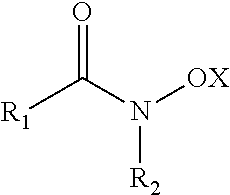Collector compositions and methods of using same in mineral flotation processes
a technology of compositions and collectors, applied in the field of ore beneficiation, can solve the problems of increased frothing and flotation, detrimental effects, etc., and achieve the effects of improving the performance of collector compositions, increasing frothing and flotation of unwanted gangue minerals, and ensuring safety
- Summary
- Abstract
- Description
- Claims
- Application Information
AI Technical Summary
Benefits of technology
Problems solved by technology
Method used
Image
Examples
examples
[0099]Aqueous solutions of chemicals are characterised in these examples by stating the mass fraction of dissolved chemicals. Mass fractions w(B) of a chemical compound B in the solution X are calculated as the ratio of the mass m(B) of dissolved chemical B, and the mass m(X) of the solution X:
w(B)=m(B) / m(X).
[0100]These data are usually stated in the unit “%” , equal to “g / 100 g” or “cg / g”.
[0101]In all compositions where constituents are mentioned with a percent value (%), this value is a mass fraction.
[0102]When using mixtures of solvent 1 (abbreviated as L1) and solvent 2 (abbreviated as L2), the mass fraction of each solvent in the mixture of solvents is also stated, abbreviated as “‘solvent 1’‘ / ’ solvent 2”(“w(L1) / %‘ / ’‘w(L2) / %‘’)’” , e. g. “propylene glycol / butylene glycol (75 / 25)” is the abbreviation for mass fractions of propylene glycol of 75% and of butylene glycol of 25% in the mixed solvent.
[0103]A fatty hydroxamic acid or its salt is considered to essentially free from me...
example 1
Preparation of Hydroxamic Acid
[0109]In a suitable three-neck reaction vessel, equipped with a condenser, an overhead stirrer, a thermocouple, and addition funnel, 43.1 g of hydroxylamine sulfate were dissolved in 52.7 g of water at between 20° C. and 25° C. After the hydroxylamine sulfate was dissolved, 59.4 g of methyl caprylate / caprate as above and 89.1 g of toluene were added into the reaction vessel. Through the dropping funnel, 70.0 g of an aqueous sodium hydroxide solution having a mass fraction of NaOH of 50% were added dropwise while maintaining the temperature between 30° C. and 40° C. The reaction was maintained with vigorous stirring at a temperature between 35° C. and 40° C. for five hours. Two phases were formed by the addition of 118.7 g of aqueously diluted sulfuric acid having a mass fraction of H2SO4 of 15% and 90.2 g of additional toluene, with the lower layer having a pH between 7 and 7.5. The phases were separated and the upper organic layer (245.1 g) was found t...
example 1a
1,2-butanediol
[0110]The procedure outlined in Example 1 was followed except 325 g of the resulting hydroxamic acid product after removal of the toluene were dissolved in 675 g of 1,2-butanediol. The liquid solution was found to contain a mass fraction of hydroxamic acid of approximately 30%, and was essentially free from starting methyl esters.
PUM
| Property | Measurement | Unit |
|---|---|---|
| Temperature | aaaaa | aaaaa |
| Temperature | aaaaa | aaaaa |
| Fraction | aaaaa | aaaaa |
Abstract
Description
Claims
Application Information
 Login to View More
Login to View More - R&D
- Intellectual Property
- Life Sciences
- Materials
- Tech Scout
- Unparalleled Data Quality
- Higher Quality Content
- 60% Fewer Hallucinations
Browse by: Latest US Patents, China's latest patents, Technical Efficacy Thesaurus, Application Domain, Technology Topic, Popular Technical Reports.
© 2025 PatSnap. All rights reserved.Legal|Privacy policy|Modern Slavery Act Transparency Statement|Sitemap|About US| Contact US: help@patsnap.com

